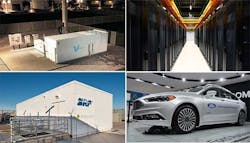Roundtable: Where Are the Best Opportunities in Edge Computing?
Today we continue our Data Center Executive Roundtable, a quarterly feature showcasing the insights of thought leaders on the state of the data center industry, and where it is headed. In today’s discussion, our panel of experienced data center executives – Rick Crutchley from Iron Mountain, Intel Software’s Jeff Klaus, David Richards from Chatsworth Products, Randy Rowland of Cyxtera Technologies, EdgeConneX CMO Phillip Marangella, and James Leach of RagingWire Data Centers – discuss where to find the best opportunities in edge computing.
The conversation is moderated by Rich Miller, the founder and editor of Data Center Frontier.
Data Center Frontier: Edge computing is a trend with many layers and flavors. What types of edge computing are most relevant in 2019? What opportunities does the evolution of edge computing create for future data center infrastructure (and when)?
PHILLIP MARANGELLA, EdgeConneX
Phillip Marangella: I agree. The Edge has many layers and flavors because the Edge is defined in varying size, scope and market based the many unique needs and requirements of our customers. Since 2010 we have been building out the Edge based on our customer’s unique requirements and how they define the Edge can range from 10kW to over 10MW.
Those network, content and cloud providers will continue to drive the of Edge’s expansion, while many proof of concepts related to autonomous vehicles, smart cities, and other IoT use cases will also help add new flavors to the Edge in 2019. The key is to be flexible, fast and scalable to support the dynamic requirements for these edge use cases.
Randy Rowland, President of Data Center Services at Cyxtera
Randy Rowland: We’re seeing a heightened focus on enterprise edge computing amongst our customer base. Essentially clients are moving their compute environments closer to their end users with smaller, more distributed deployments. This evolution creates great opportunity for data center providers. But it also underscores the importance of global scale, flexibility, and interconnection.
For most mid-to-large enterprises, it’s not enough for a data center provider to be in just one or two markets. A global footprint with a consistently high caliber of operations expertise is table stakes for enterprise customers that want to deploy edge data centers in multiple markets. Enterprises should look for providers that can offer a single service agreement for multiple locations yet give them the flexibility to move capacity between markets without penalty.
“For most mid-to-large enterprises, it’s not enough for a data center provider to be in just one or two markets”
Randy Rowland, Cyxtera
Time to provision interconnection and dedicated infrastructure impedes edge computing adoption. Enterprises should look to data center providers that not only offer diverse, low-latency on-ramps to cloud providers and cloud edge POPs, as previously discussed. They need to seamlessly link their data center to the ecosystem of service providers in a metro region.
DAVID RICHARDS, Chatsworth Products Inc. (CPI)
David Richards: The evolution of edge computing, which is still taking shape, requires early pioneers to be self-sufficient as the market leaders’ progress to new operation and facility models. Many in-house test facilities are already working with the support of co-alliances and it appears to still be a race to the finish line. As the Internet of Things (IoT) and artificial intelligence (AI) become standard, edge computing will continue to trend up to support these markets.
In 2019 and 2020, 5G buildout will be one large, universal application. Carriers will need to deploy more compute and storage closer to users to address latency. In parallel, the CDNs will likely expand their regional presence to support streaming and eventually AR/VR.
The other major driver will be Industry 4.0. There is tremendous value in collecting, trending and analyzing data from manufacturing operations. But, doing that in the cloud is cost-prohibitive for most data other than top-level reporting. This will require some compute on-premise.
Jeff Klaus, General Manager of Intel Data Center Management Solutions
Jeff Klaus: In 2019 the edge use case I usually see is “High Bandwidth, Large Volume Applications.” For example
- Mobile HD video
- Autonomous driving
- Content delivery
- Healthcare (imaging and diagnostics)
- Caching and surveillance
Then followed by “Multi-access Edge Computing (MEC)
- Enterprise focused small cell services for stadiums and high-density locations
- Unified Customer Premise Equipment (uCPE) applications
- Retail
The next set of use cases after that are going to be moved up with 5G enabling a network for machines to talk to machines, and machines to talk to humans. We need the new networks to enable the amount of simultaneous connections all the devices require.
RICK CRUTCHLEY of Iron Mountain.
Rick Crutchley: Today’s edge is still focused on localizing specific business applications / content within colocation facilities in less populated cities to maximize performance for specific end users – or for disaster recovery. The size of the colo need depends on the size of the customer / end-user base. SDN (software-defined networking) continues to make edge data centers in less populated cities a viable option, offering colocation customers integration and connectivity to necessary cloud providers. Additionally, with on-ramps like Direct Connect and ExpressRoute proliferating and the commoditized cost of fiber, end users have multiple choices and negotiating power to make the most out of their edge deployments.
Moving forward, innovations like Amazon Web Services’ Outpost, Snowball and Snowmobile will bring true edge computing closer to mass-market implementation. Future solutions featuring data center containers deployed in remote, global locations such as telecom towers are being seriously contemplated and tested. With widespread 5G technology around the corner, smart cities, and game-changing network-based offerings nearing completion (self-driving cars, etc.), edge computing is knocking on the door. We are still in the early stages and a couple years out still for true edge adoption, but the momentum is starting to build.
JAMES LEACH, RagingWire Data Centers
James Leach: Tech people love to name new IT architectures. A few months ago, we coined a phrase that combines Hyperscale + Edge to create “hedge” data centers. Clearly two of the biggest data center trends in 2018 were the dominance of massive, hyperscale cloud deployments and the emergence of new edge computing architectures.
We expect to see data center colocation products seamlessly integrating hyperscale and edge data centers to support new enterprise applications to support advanced technologies such as artificial intelligence, Internet of Things, blockchain, virtual reality, big data, etc. Keep an eye on the 100,000+ cell towers in the U.S. as a platform for edge roll-outs.
NEXT: What strategies are driving success in the market for enterprise colocation and cloud?
Keep pace with the fact-moving world of data centers and cloud computing by following us on Twitter and Facebook, connecting with me on LinkedIn, and signing up for our weekly newspaper using the form below:
About the Author






